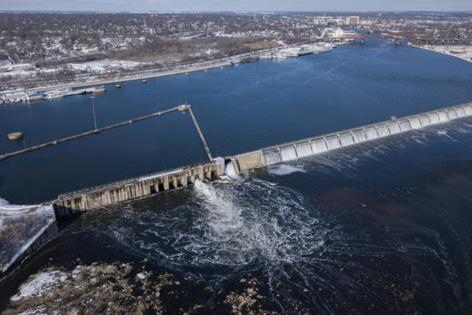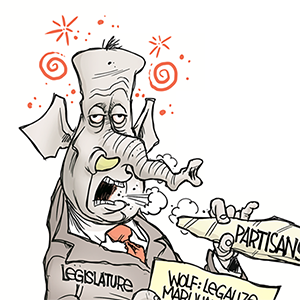Trump says he won't fund invasive carp barrier unless Illinois Gov. JB Pritzker 'asks.' But the money has already been set aside
Published in News & Features
As tensions rise between Illinois politicians and President Donald Trump over his plans to deploy the National Guard to Chicago, the latter contrasted Democratic governors’ resistance to their desire for federal assistance on an issue that has plagued the Great Lakes for decades: invasive carp.
“There’s a way of getting rid of those, very expensive,” Trump told reporters at the Oval Office on Monday, “and I didn’t get a request from the governor of Illinois, (which) is affected maybe more than anybody else, right? And I think until I get that request from that guy, I’m not going to do anything about it.”
The president was likely referring to a $1.15 billion infrastructure project at the Brandon Road Lock and Dam on the Des Plaines River in Joliet, to build the last, multipronged line of defense against silver and bighead carp moving upstream.
It’s the culmination of decadeslong efforts between Illinois, Michigan and the federal government to stop the invasive fish, which pose a significant threat to the native species and aquatic ecosystems of the Great Lakes, as well as its billion-dollar fishing and boating industries. The fish are currently held back by unreliable electrical barriers near Romeoville.
The federal government will cover 90% of the project’s construction costs, with $274 million funding the first phase, which started in May, and $765 million going toward the next two phases. The latest estimates from the U.S. Army Corps of Engineers’ Rock Island District — the project’s main federal sponsor — set the price tag for the next two phases at $646 million. Michigan and Illinois are contributing $64 million and $50 million, respectively, toward the project total. In May 2024, Illinois and Michigan members of Congress secured an increase in the federal cost share for operations and maintenance after construction to 90%.
Trump could be threatening to withhold federal funds for the project even though Congress has already appropriated them. Since the beginning of his second term, he has done so across several federal agencies, freezing funds and grant programs. The nonpartisan watchdog arm of Congress, the Government Accountability Office, as well as the U.S. Senate Committee on Appropriations, have called such actions illegal and unconstitutional, in some cases arguing they violate the Impoundment Control Act of 1974, which determines when a president can cancel federal funding that has been appropriated.
It’s a law that the president has, in turn, called unconstitutional, previously saying he’d challenge it in court and “get Congress to overturn it.” He has not filed a lawsuit directly challenging the law.
On Monday, Trump credited Michigan Democratic Gov. Gretchen Whitmer — whom he incorrectly called “Kristi” — for working with his administration on the issue of invasive carp.
“She came and she wanted to know if it’s possible for us to do something about it,” he said. “And I said, ‘Well, I’ll do (that) but I think it’s appropriate that the person from Illinois, the governor from Illinois, asks also.’ It’s a tremendously expensive project.”
In an emailed statement to the Tribune, Gov. JB Pritzker spokesperson Matt Hill cautioned against taking the statements “at face value,” he said, “as many are lies.” The state hosted partners at the project site July 24, Hill said, including high-ranking Trump administration officials from the Army Corps and state officials from Michigan.
“With Illinois leading the way, partners shared positive updates on the progress we are making to protect the Great Lakes. Illinois has done its part for more than a decade, and Governor Pritzker has pressed for even more progress for the past six years of his tenure,” Hill said. “While Trump lies to play political blame games, Illinois will focus on delivering results. If the White House needs an update on the project, we welcome their outreach but have not received any to date.”
Mistrust between Pritzker and Trump already delayed construction earlier this year. In February, a groundbreaking ceremony was canceled as the state postponed a property closing on the land, anticipating a future lack of federal funding after the administration withheld grants for the Illinois Department of Natural Resources from the Bipartisan Infrastructure Law, halting 70 unrelated projects across the state.
While federal funds had been approved for phase one of the project, state officials had expressed concerns about proceeding without assurances from the administration that funding critical for the next two phases, as well as the operation and maintenance costs, wouldn’t be held back and leave Illinois taxpayers “on the hook.”
After the snag, the project resumed in May when the state of Illinois finalized its acquisition of the 50-acre piece of property needed for construction after Trump signed an executive order that the governor’s office said addressed the state’s concerns.
Even then, Trump called out Pritzker, blaming him for not allowing the project to start.
“Illinois Governor JB Pritzker decided to delay the State’s acquisition of property, which is necessary for construction to begin,” the order read.
In response, Pritzker said the Trump administration “decided to finally meet their obligations to the state of Illinois and the Great Lakes region.”
“I have made clear that — in the interest of saving the Illinois taxpayer potentially hundreds of millions in liabilities — we would only move forward if given the proper assurances that the federal government would hold up their end of the bargain,” Pritzker said.
Phase one of the project includes site preparation and bedrock removal, as well as the installation of some of the multilayered technologies, which include a bubble barrier that removes small fish trapped under barges or carried in their wake and an acoustic deterrent that creates painful sound waves. The second and third phases will include an electric barrier and more acoustic deterrents. At the end, a flushing lock will send any remaining larval fish and eggs back downstream.
Invasive across the United States, these carp include silver, bighead, grass and black carp. The fish were introduced in the 1960s to get rid of seaweed without using chemicals in aquaculture facilities and sewage ponds in Arkansas.
But after extreme flooding events in the 1980s and 1990s, the carp escaped into the Mississippi River basin — the third largest in the world — spreading to 31 states. Some were also released after breeding experiments failed.
Silver and bighead carp are particular threats to native species as they have no natural predators in American waterways and likely never will, meaning their populations can grow uncontrollably.
Additionally, they represent a challenge since they can’t be easily caught as they don’t care for bait; they are “filter feeders” and eat plankton from the base of the aquatic food chain. Because of their large numbers and reproductive capacity, silver and bighead carp can eat faster than and starve native fish and mussels.
Loud motors can scare silver carp into jumping up to 5 feet in the air, sometimes leaving recreational boaters with bloody noses, black eyes and bruises. In the Great Lakes, invasive carp could threaten billions in tourism dollars.
Frustrated by delays in federal and state deterrence projects, and annoyed by their own encounters with the flying fish, residents of a small town in western Illinois saw both a challenge and an opportunity in the large numbers of silver carp that infested their stretch of the Illinois River. Though they couldn’t be easily caught with traditional fishing gear, the silver carp could be scooped mid-leap with landing nets.
For almost 20 years, the village of Bath has hosted the Original Redneck Fishing Tournament, an annual competition drawing people from all over the country and the world to remove thousands of pounds of large silver fish from the river.
Other citizen-led and similarly theatrical efforts include commercial fishermen or “carp cowboys” rounding up countless fish farther up the Illinois waterway. Scientists are employing creative measures, too, such as using unmanned kayaks to gather data at the Emiquon Nature Preserve so fishermen can target over 150,000 silver, bighead and common carp from its 3,000 acres of wetlands, which they breached almost a decade ago after heavy flooding.
The state of Illinois has also spearheaded a campaign to rebrand invasive carp as “copi” and give it a more palatable name. A high-quality protein, carp can be fried and eaten as a meal of traditional fish and chips, or made into patties, gumbo, tacos, nuggets, rangoon, empanadas and sliders.
-----------
—Chicago Tribune’s Olivia Olander and Rick Pearson contributed.
____
©2025 Chicago Tribune. Visit at chicagotribune.com. Distributed by Tribune Content Agency, LLC.







Comments